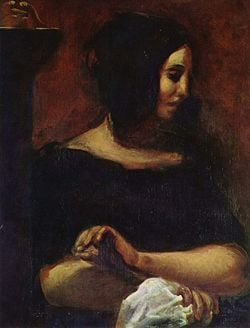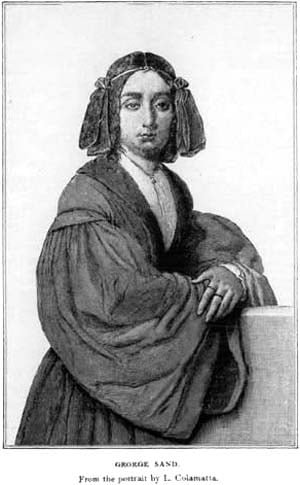George Sand

George Sand was the pseudonym of the French novelist and feminist Amantine-Lucile-Aurore Dupin, later Baroness Dudevant (July 1, 1804 – June 8, 1876). Sand was an author of romance novels. The romance novel, as distinct from the ninteenth century tradition of Romanticism is one in which love conquers all, overcoming all barriers, including those of social class. In the traditional formula, two lovers face insurmountable obstacles which must be overcome in order to become one. The popularity of the romance novel played a role in the development of "romantic love" as the basis for marriage in Western culture. Her novels also expressed her love of the countryside.
Life
Born in Paris to a father of aristocratic lineage (from a grandaughter of Maurice, comte de Saxe and a distant relative of Louis XVI) and a mother of common descent, Sand was raised for much of her childhood by her grandmother at the family estate, Nohant, in the French region of Berry, a setting later used in many of her novels. In 1822, she married Baron M. Casimir Dudevant (1795–1871), and they had two children, Maurice (1823–1889) and Solange (1828–1899).
Her first published novel, Rose et Blanche (1831) was written in collaboration with Jules Sandeau, from whom she allegedly took her pen name, Sand. Her reputation was questioned when she began sporting menswear in public—clothing far sturdier and less expensive than a noble woman's dress. This male "disguise" enabled Sand to circulate more freely about Paris, and gave her increased access to venues that might have been denied to a woman of her social standing. This was an exceptional practice for the 19th century, where social codes—especially in the upper class—were of the highest importance. As a consequence Sand lost many of the privileges attached to her status as a Baroness. (Ironically, the mores of this period allowed women of higher classes to live physically separated from their husbands without losing face, provided they did not show any blatant irregularity to the outer world.) She was linked romantically with Alfred de Musset (summer 1833–March 1834), Franz Liszt and Frédéric Chopin (1810-1849) whom she had met in Paris in 1831. Later in life, she corresponded with Gustave Flaubert; despite their obvious differences in temperament and aesthetic preference they eventually became close friends.
She was engaged in an intimate friendship with actress Marie Dorval, which led to widespread but unconfirmed rumors of a lesbian affair. [1].
In Majorca one can still visit the (then abandoned) Carthusian monastery of Valldemossa, where she spent the winter of 1838–1839 with Frédéric Chopin and her children. [2] This trip to Mallorca was described by her in Un Hiver à Majorque ("A Winter in Mallorca"), published in 1855.
She left Chopin shortly before he died from tuberculosis.
Works
Drawing from her childhood experiences of the countryside, she wrote the rural novels La Mare au Diable (1846), François le Champi (1847–1848), La Petite Fadette (1849), and Les Beaux Messieurs Bois-Doré (1857).
Her other novels include Indiana (1832), Lélia (1833), Mauprat (1837), Le Compagnon du Tour de France (1840), Consuelo (1842–1843), and Le Meunier d'Angibault (1845).
Further theatrical and autobiographical pieces include Histoire de ma vie (1855), Elle et Lui (1859) (about her affair with Musset), Journal Intime (posthumously published in 1926), and Correspondence. Sand often performed her theatrical works in her small private theatre at the Nohant estate.
In addition, Sand authored literary criticism and political texts. Her most widely used quote was: "There is only one happiness in life, to love and be loved." Also, she was one of the few female pipe smokers.
She was known well in far reaches of the world, and her social practices, her writings and her beliefs prompted much commentary, often by other luminaries in the world of arts and letters. A few excerpts demonstrate much of what was often said about George Sand:
"She was a thinking bosom and one who overpowered her young lovers, all Sybil — a Romantic." V.S. Pritchett (writer)
"What a brave man she was, and what a good woman." Ivan Turgenev (novelist)
"The most womanly woman." Alfred de Musset (poet)
George Sand died at Nohant, near Châteauroux, in the Indre département of France on June 8, 1876 at the age of 72 and was buried in the grounds of her home at Nohant. In 2004, controversial plans were suggested to move her remains to the Panthéon in Paris.
Works
- Voyage En Auvergne (1827, Autobiographical sketch)
- Compagnon Du Tour De France (1840)
- La Petite Fadette (1848)
- Chateau Des Désertes (1850)
- Histoire De Ma Vie (1855, Autobiography up to the revolution of 1848)
Novels
- Indiana (1831)
- Rose Et Blanche (1831, with Jules Sandeau)
- Lelia (1833)
- Andrea (1833)
- Mattea (1833)
- Jacques (1833)
- Leone Leoni (1833)
- Simon (1835)
- Mauprat (1837)
- les Maîtres Mosaïtes (1837)
- l'Oreo (1838)
- l'Uscoque (1838)
- Un Hiver A Majorque (1839)
- Pauline (1839)
- Gabriel-Gabrielle (1839)
- Horace (1840)
- Consuelo (1842)
- la Comtesse De Rudolstady (1843, a sequel to Consuelo)
- Jeanne (1844)
- Teverino (1845)
- Peche de M Antoine (1845)
- Le Meunier D'Angibault (1845)
- La Mare Au Diable (1846)
- Lucrezia Floriani (1846)
- Francois Le Champi (1847)
- Les Maîtres Sonneurs (1853)
- Elle Et Lui (1859)
- Jean De La Roche (1859)
- L'Homme De Neige (1859)
- La ville Noire (1860)
- Marquis De Villemer (1860)
- Mademoiselle La Quintinie (1863)
- Laura, Voyage Dans Le Cristal (1864)
- Le Dernier Amour (1866, dedicated to Flaubert)
Plays
- Francois Le Champi (1849)
- Claudie (1851)
- Le Mariage De Victorine (1851)
- Le Pressoir (1853, Play)
- French Adaptation of As You Like It (1856)
- Le Marquis De Villemer (1864)
- L'Autre (1870, with Sarah Bernhardt)
Depiction in film and television
- Chopin (2002, director: Jerzy Antczak) starred Danuta Stenka as George Sand and Piotr Adamczyk as Chopin.
- Les Enfants du siècle (1999) starring Juliette Binoche as George Sand and Benoît Magimel as Alfred de Musset
- Impromptu (1991) starred Judy Davis as George Sand and Hugh Grant as Chopin.
- Notorious Woman (1974) a 7-part BBC miniseries starring Rosemary Harris as George Sand and George Chakiris as Chopin.
ReferencesISBN links support NWE through referral fees
- Eisler, Benita. Naked in the Marketplace: The Lives of George Sand, Counterpoint, a member of the Perseus Books Group, 2006. ISBN 1582433496
- Garval, Michael D., "A Dream of Stone": fame, vision, and monumentality in nineteenth-century French literary culture, University of Delaware Press, 2004. ISBN 0874138620
- Harlan, Elizabeth. George Sand, Yale University Press, 2004. ISBN 0300104170
- Rovin, Jeff. Cat Angels, Harper Paperbacks. ISBN 0061009725
External links
All links retrieved June 15, 2017.
- Works by George Sand. Project Gutenberg
- Doumic, René - George Sand, some aspects of her life and writings, available for free via Project Gutenberg
- In French:
- Caro, Elme - George Sand, available for free via Project Gutenberg
- Roy, Albert le - George Sand et ses amis, available for free via Project Gutenberg
Credits
New World Encyclopedia writers and editors rewrote and completed the Wikipedia article in accordance with New World Encyclopedia standards. This article abides by terms of the Creative Commons CC-by-sa 3.0 License (CC-by-sa), which may be used and disseminated with proper attribution. Credit is due under the terms of this license that can reference both the New World Encyclopedia contributors and the selfless volunteer contributors of the Wikimedia Foundation. To cite this article click here for a list of acceptable citing formats.The history of earlier contributions by wikipedians is accessible to researchers here:
The history of this article since it was imported to New World Encyclopedia:
Note: Some restrictions may apply to use of individual images which are separately licensed.
